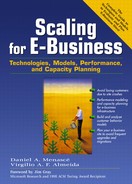2.5. Building a CBMG
We describe in this section the approaches that can be followed to build the static portion of a CBMG. The dynamic portion is obtained as part of a workload characterization process, as described in Chapter 11.
To determine the static portion of the CBMG, the following steps should be followed.
1. |
Determine the set of functions provided to the customers of the e-commerce site. While some of the functions (e.g., Search, Login) may be found in most e-commerce sites, there are functions that are characteristic of certain e-commerce sites or of specific types of e-commerce sites. Table 2.2 gives some examples of functions common to most sites and functions characteristic of types of e-commerce sites. The first part of the table lists some functions, such as Login, Register, Select, and Browse, that are common to most sites. Then, the table presents some examples of functions commonly found in retail, online trading, and information distribution e-commerce sites. Each function should be associated with a state of the CBMG. |
2. |
Refine the set of functions according to resource consumption. Each function requires a certain amount of processing by the IT infrastructure of the e-commerce site. Therefore, it is important to separate functions that may require significantly different types of processing. For example, in the online trading case, it may be necessary to separate the Trade function into Trade Stock, Trade Mutual Fund, and Trade Bonds since they may require very different workflows. Similarly, a site that sells multimedia presentations may want to distinguish Download Audio from Download Video due to the significantly different bandwidth requirements imposed by each type of multimedia product. |
3. |
Determine the transitions between states. At this step, one needs to examine all possible transitions between states of the CBMG. This can be done by analyzing the layout of the pages offered to customers of the e-business site. For example, consider that the home page of an online trading site makes available the following functions: Open Account, Get Quotes, Login, Trade, Asset Planner. Then we know that from the state Home, there are transitions in the CBMG to each of these states. Then, one has to look at the possible functions available at each of the pages that are used when invoking these functions. For example, the Trade function may be accessible from the Get Quotes page. |
The next section describes metrics for Web and e-business sites aggregated over many visits to a site. Section 2.7 shows how the CBMG, with its static and dynamic aspects, can be used to obtain metrics related to customer behavior during each visit.
..................Content has been hidden....................
You can't read the all page of ebook, please click here login for view all page.
